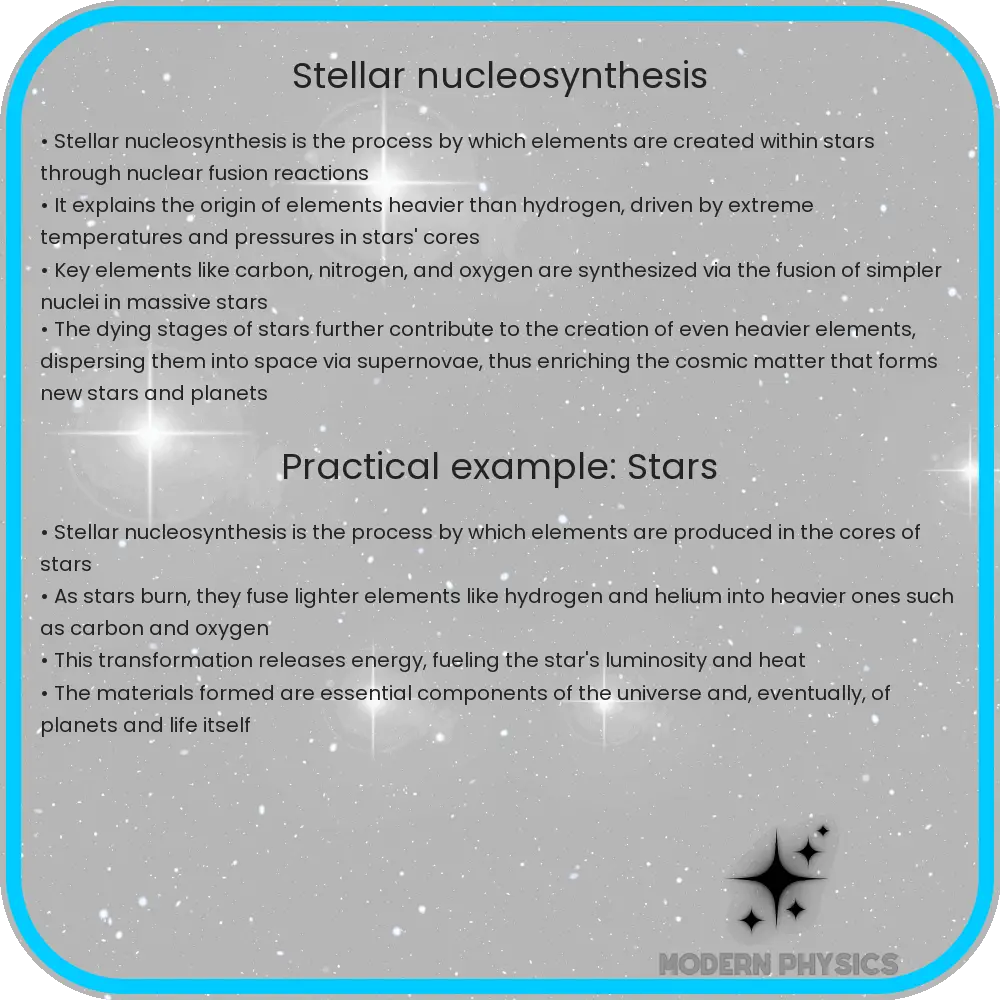Explore the fascinating process of stellar nucleosynthesis, where stars forge chemical elements, shaping the cosmic landscape and contributing to the universe’s diversity.

Stellar Nucleosynthesis: Unveiling the Cosmic Forge
Stellar nucleosynthesis is the process by which the natural abundances of the chemical elements within stars change due to nuclear fusion reactions in their interiors. This transformative process forms the essence of how elements are created from hydrogen and helium, shedding light on the cosmic genealogy of the universe’s material contents.
Core Processes in Stellar Nucleosynthesis
The core mechanism of stellar nucleosynthesis begins in the hearts of stars, where extreme temperatures and pressures facilitate nuclear reactions. The most fundamental process is the proton-proton chain reaction, dominant in stars like our Sun. This series of reactions converts hydrogen into helium, releasing energy that powers the star:
- 4 1H → 4He + 2e+ + 2νe + energy
In more massive stars, the carbon-nitrogen-oxygen (CNO) cycle predominates, acting as a catalytic process whereby hydrogen is converted into helium, with carbon acting as a catalyst.
Elements and Stars: Crafting the Periodic Table
The tale of element creation does not end with helium. As stars age and evolve, they activate further nuclear processes, forging heavier elements through mechanisms such as the triple-alpha process, which creates carbon:
- 3 4He → 12C + energy
This cascade of nuclear reactions continues, constructing the building blocks of the universe, from carbon and oxygen up to iron. Each type of star contributes differently to the galactic alchemy. While massive stars can synthesize elements up to iron through sequences of fusion reactions, the creation of elements heavier than iron requires the input of additional energy and occurs primarily during supernova explosions or neutron star collisions, events that scatter newly formed elements across the cosmos.
The lifecycle of stars, from their formation to their eventual demise, is intimately tied to the synthesis of elements. The remnants of dead stars, such as supernovae remnants or neutron star mergers, are key sites for the nucleosynthesis of heavier elements, enriching the interstellar medium with the materials necessary for the formation of new stars, planets, and eventually, life itself.
The Role of Supernovae in Element Formation
Supernovae play a critical role in the cosmic cycle of element formation. During these colossal explosions, conditions become favorable for the rapid neutron capture process (r-process), which is responsible for creating approximately half of the elements heavier than iron, including gold, uranium, and platinum. The material ejected from these explosions mixes with the interstellar medium, seeding future generations of stars and solar systems with rich assortments of elements.
The Final Stages: White Dwarfs and Neutron Stars
Stars that do not end their lives in supernovae fade into white dwarfs or, in the case of very massive stars, collapse into neutron stars. These end stages contribute to nucleosynthesis in less direct but equally fascinating ways. White dwarfs can lead to Type Ia supernovae, contributing to the iron group elements’ abundance in the universe. Neutron stars, particularly when they collide, are thought to be major sites for the production of heavy r-process elements.
Observational Evidence and Cosmic Abundances
The predictions of stellar nucleosynthesis are not without observational backing. Spectroscopic studies of stars and nebulae, cosmic ray composition analyses, and examination of meteoritic material all contribute to our understanding of element formation. The distribution of elements seen throughout the universe aligns remarkably well with theoretical predictions, providing strong support for the models of stellar nucleosynthesis.
Conclusion
Stellar nucleosynthesis is a fundamental process that illustrates the interconnectedness of all cosmic phenomena. From the fusion of hydrogen atoms in a young star to the dramatic finale of a supernova, the lifecycle of stars is deeply entwined with the creation of the very elements that compose the universe, including the planets and life itself. This grand cosmic forge operates over billions of years, recycling material from one generation of stars to the next, enriching the cosmos with a diverse array of elements. It is a process that reveals the beauty and complexity of the universe, showing us that we are, in a very real sense, made of star stuff.
